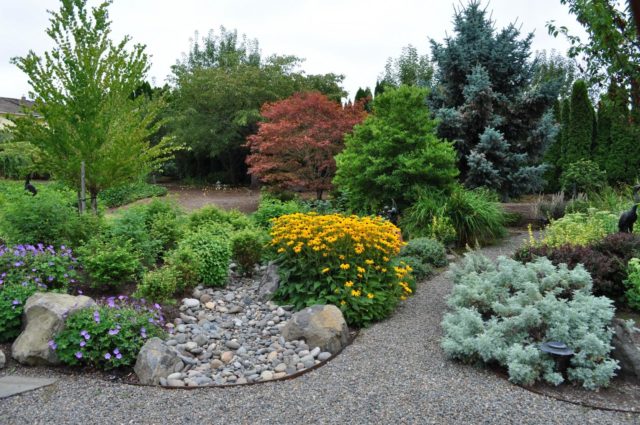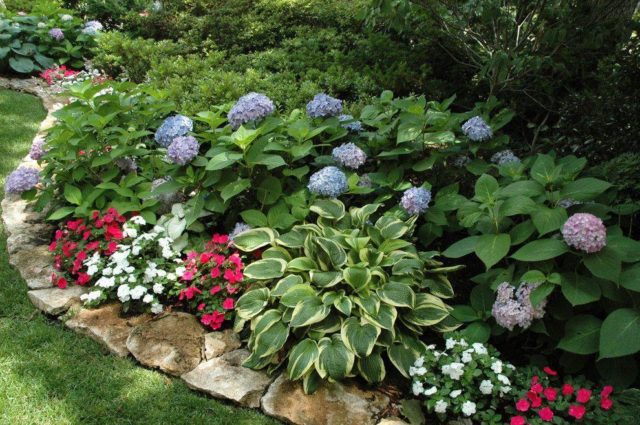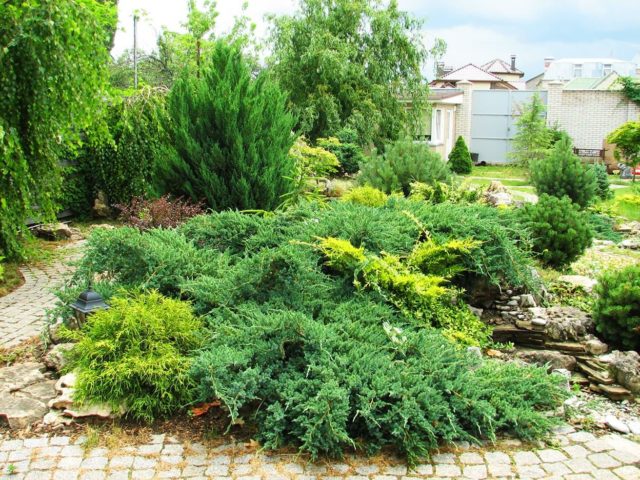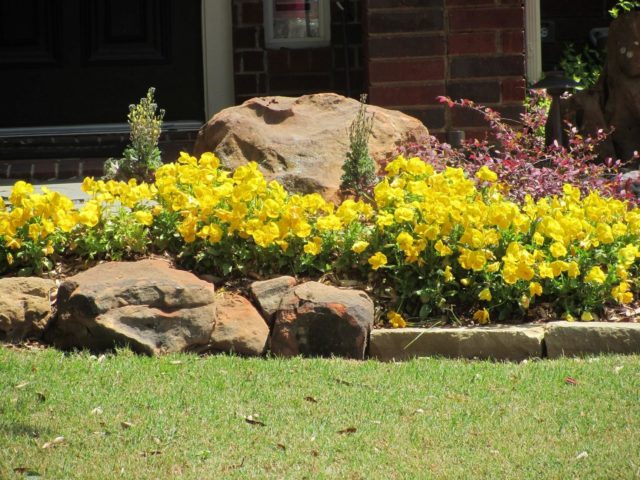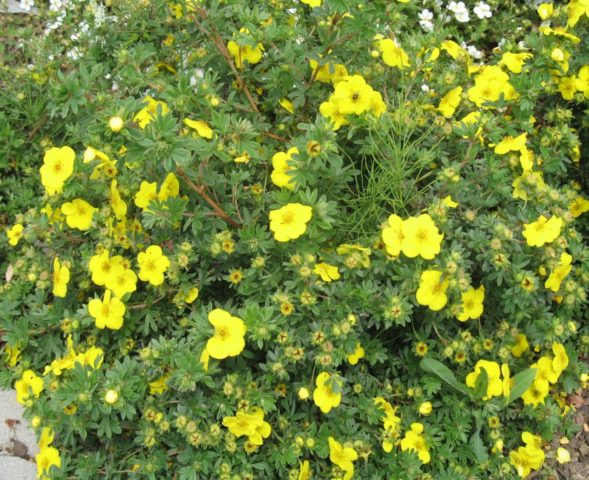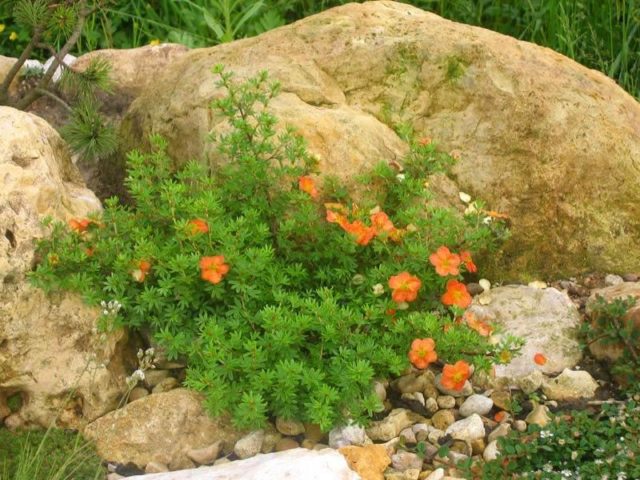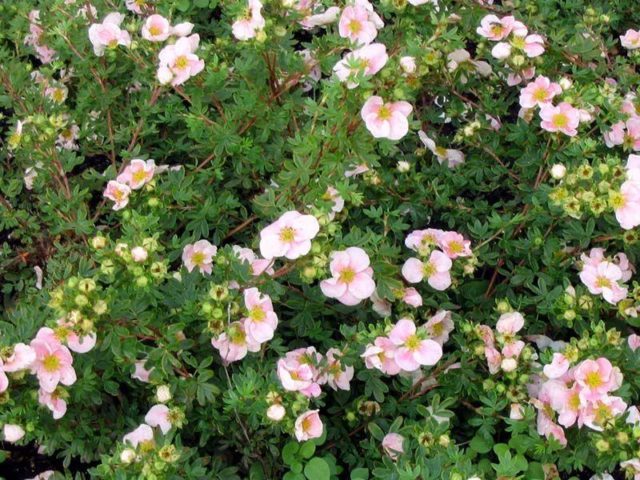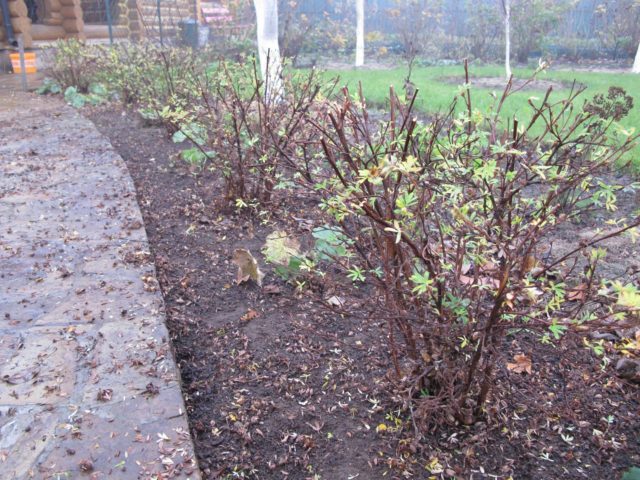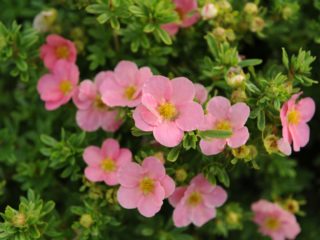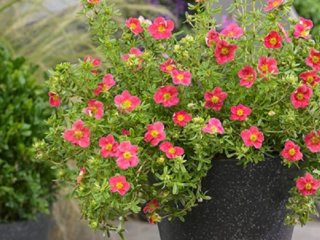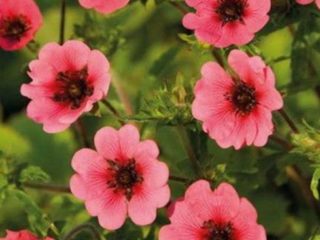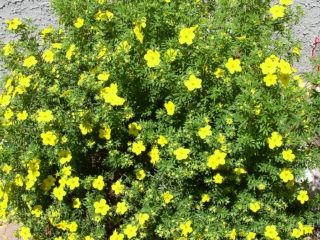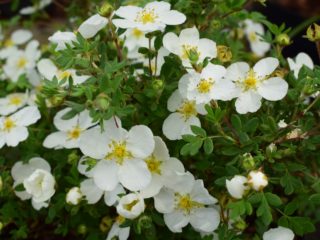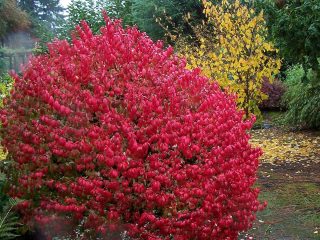Content
- 1 What does cinquefoil combine with in landscape design?
- 2 How to correctly compose compositions depending on the variety and variety of cinquefoil
- 3 Features of the use of cinquefoil in garden landscape design
- 4 Compositions of cinquefoil in the landscape of a personal plot
- 5 Kuril tea hedge
- 6 Rules for care and pruning for best results
- 7 Conclusion
Cinquefoil is one of the largest species of flowering plants in the Rosaceae family. The name is associated with the Latin designations of power, strength and might. Cinquefoil in landscape design can surprise with its decorative properties and give the composition a finished and impressive look.
What does cinquefoil combine with in landscape design?
Cinquefoil is called “Kuril tea”. This is due to one of the areas of application. Kuril tea in decoctions and infusions can work wonders. In cultivation, it is an ornamental plant, which is widely used for growing in monogroups, as well as for decorating borders or flower arrangements.
The shrub is called cinquefoil because of the similarity of the leaf plates to the paws of animals. By its type, the plant is a universal, perennial shrub. Using cinquefoil in landscape design has several advantages:
- externally, the crop looks like bushes with a spherical crown, which can hide flaws or emphasize the advantages of any garden composition;
- the shrub is able to coexist with any flower crops, since it is not aggressive and does not grow into neighboring areas;
- varieties and varieties have high adaptive qualities, allowing them to adapt to poor soils, and the ability to grow in any area.
How to correctly compose compositions depending on the variety and variety of cinquefoil
Photos of cinquefoil in landscape design can often be found in the works of famous designers. Most often, the following crops become neighbors who can provide company for herbaceous shrubby cinquefoil in garden design:
- thuja occidentalis;
- lavender;
- tall roses.
White cinquefoil in landscape design is combined with cosmos, as well as with sedum from the Crassulaceae family. Yellow and white varieties are used to dilute coniferous plantings. Phloxes up to 35 cm high will be good neighbors for low-growing varieties. The selection for central compositions is carried out by a combination of shades with varieties of spireas and barberries.
Features of the use of cinquefoil in garden landscape design
Partners for Kuril tea in landscape design are selected according to different principles. Choose low-growing shrubs that can be planted in close proximity. In addition, they must have a dense crown and create a contrast in the type of flowering. For the neighborhood they plant:
- deciduous rhododendron;
- juniper;
- heather.
Compositions of cinquefoil in the landscape of a personal plot
The openwork green foliage, the spherical silhouette of the crown, flowers with a regular structure, which against the background of green leaf plates seem bright and larger, make the shrubby cinquefoil indispensable in the design of any garden.
Among the variety of compositions for the landscape of a personal plot, choose one of the subspecies:
- Hedge. Bushes are planted along borders and paths. They can serve as limiters of compositional space, separating one area from another. A distance of up to 4 cm is left between plants so that when the cinquefoil grows it does not interfere with the neighboring plant;
- Rock gardens. Most often, compositions are decorated with stones of different types and sizes. Coniferous greenery is planted on the territory of rock gardens. Potentilla bushes can become an island, which with bright large flowers will dilute the predominant green color of the foliage of the entire composition;
- Flowerbed. Cinquefoil is actively used for combination with other flowering plants. They can occupy a central place or be planted in a row with other species that are suitable in height;
- Solitary composition. Landscape designers use multi-colored varieties of cinquefoil as soloists. They are planted near reservoirs in separate bushes, then watering is reduced to a minimum. A pond designed in this way looks especially impressive in the landscape design of a garden, as can be seen from various projection photos of the cinquefoil.
Shrubby cinquefoil is perfect for growing on rocky steps: in numerous photos of landscape design you can see how large-flowered spherical bushes significantly change their overall appearance when flowering.
Single bushes are also planted around gazebos or verandas. Most often, shrubs are placed along the perimeter of buildings, schematically marking the boundaries.
Kuril tea hedge
Potentilla bushes are used in the landscape design of a site for hedges; in the photo it is noticeable that the bushes hold their shape well and, if pruned in a timely manner, almost do not grow. Certain varieties of cinquefoil are used to decorate hedges:
- Gold Finger. This is a popular variety that is used to decorate hedges with dark green leaves and large yellow flowers, the diameter of which reaches 7 cm. Flowering begins with the arrival of warmth and lasts until October. A dense crown is easily formed according to the established pattern. The height of the bushes reaches 1.5 m, but when pinching the apical shoots it can be significantly lower. Yellow cinquefoil is often used to delimit space in landscape design. Against the background of green petals, yellow flowers look especially impressive.
- Red Ace. This variety of cinquefoil grows up to 65 cm and has creeping shoots. From the beginning of summer, the shade of the petals acquires an orange-red tone, and by the beginning of autumn it becomes orange-yellow. When forming bushes, the ability of shoots to spread along the ground is taken into account, so the lower lateral formations are pinched at the germination stage;
- Princesses. The variety has two varieties: white and pink. Pink princesses are alternated with a white variety to create a more spectacular hedge. Flowers reach 3.5 cm, bushes grow up to 80 cm.The variety loves fertile soil and is suitable for planting in partial shade. The pink variety may fade when exposed to sunlight and become creamy.
For hedges, cinquefoil is planted in compliance with certain rules of landscape design. Leave about 5 cm from the path so that the bushes can grow and not interfere with movement.
Rules for care and pruning for best results
Spring pruning is carried out before buds begin to appear in early spring. Use a rake to clear the ground around the bush, remove remaining leaves and dried parts of the plant. Then the silhouette is inspected and the cutting pattern is determined. It is taken into account that the sunny side stimulates more active growth, so one part of the bushes is always slightly longer than the other.
Most often, shrubby cinquefoil in garden landscape design is formed into a sphere-like shape; this type can be seen in numerous photos. When forming the crown, several basic rules are followed:
- branches are shortened by no more than half;
- long shoots are cut by a third;
- broken and dried branches are cut off completely;
- After pruning, the sections are treated with garden varnish.
Trimming cinquefoil in landscape design performs several tasks simultaneously:
- forms a beautiful crown;
- promotes abundant flowering;
- rejuvenates the plant.
In the fall, spring pruning is adjusted. Its main task is to remove frozen shoots and eliminate diseased branches.
When caring for cinquefoil, it is recommended to follow agricultural practices and not deviate from the generally accepted scheme. This will allow you to grow a healthy shrub that blooms profusely throughout the summer. Basic Rules:
- water the cinquefoil as the top layer of soil dries;
- watering is carried out in the evening, after sunset;
- weeds are systematically removed;
- loosen the soil around the bushes;
- During the growing season, nitrogen- and potassium-containing mixtures are added to form greenery, as well as during the flowering period;
- be sure to carry out annual pruning, as well as pruning for the purpose of rejuvenating the bushes once every 4 - 5 years;
- During wintering, the soil around the bushes is mulched, this protects the roots from freezing.
Conclusion
Cinquefoil in landscape design can perform different functions. Its combination with other varieties of flowering plants looks no less impressive than planting individual bushes. Kuril tea, subject to pruning rules, can revive any landscape design composition and make the garden bright and blooming.
